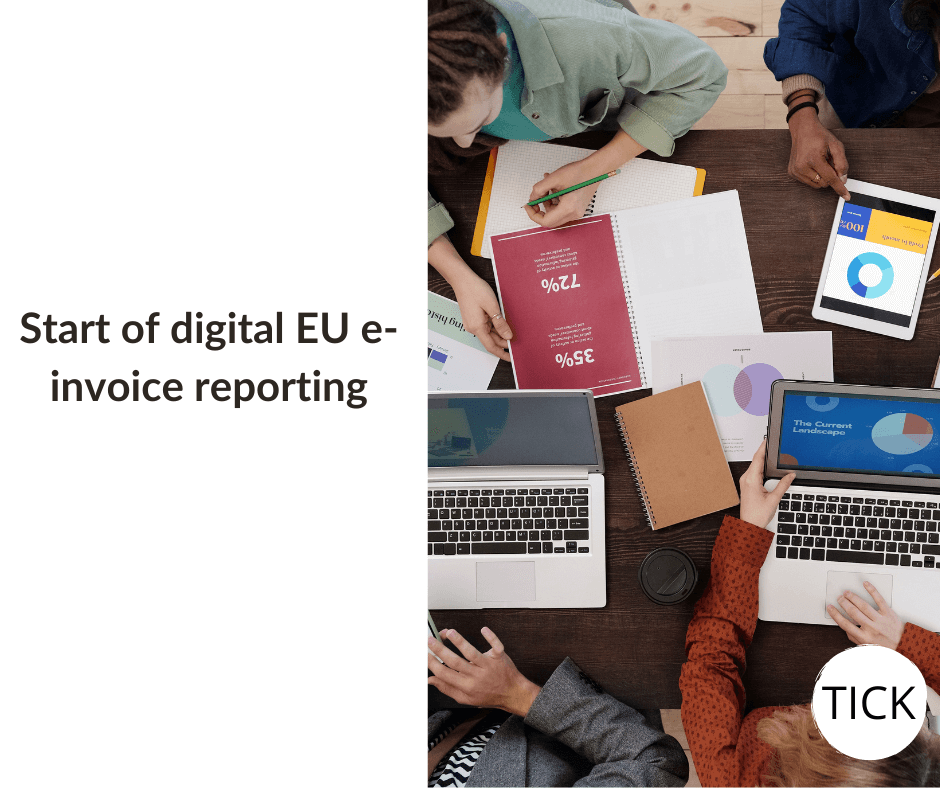The European Commission is committed to digital harmonization. Continuous “CTC” transaction control options for e-VAT invoices and real-time reporting. Amendments to the VAT Directive until October 2022.The European Commission (EC) is reviewing to introduce harmonized digital reporting requirements (DRR) (formerly known as „
Transaction-based reporting” ) in 27 Member States. The public consultation ended in May 2022, contributing to changes to the VAT Directive by the end of 2022. Next, a number of questions regarding e-invoicing standards need to be answered. This assessment has five parts:
- Full harmonization with the interconnected intra-community and national e-invoicing system of the EU; or
- Partial harmonization only with intra-community live reporting with member states that can (or may not!) introduce their own system
- Will the transactions have to be settled first with the tax authorities and what method would be used if not continuous checks of the transactions?
- Transaction scope – B2G, B2B, B2C, exempts etc.;
- Taxpayers’ matters – including the use of pre-filled VAT returns;
Implementation by 2024?The purpose of the DRR review is to understand what data can be collected, how and how it can be shared between tax authorities to help leverage VIES and produce reliable live transaction data that could make VAT fraud immediately visible. The EC hopes to issue a VAT Directive changing the regulations by the end of 2022. This could then be implemented by 2024 or 2025.Digital Reporting Requirements (DRR) is one of the three parts of
VAT in the digital age reform (see below), and it is part
the EU Tax Action Plan 2020 announced in 2020.1. DRR – full or partial harmonization?Following the public consultation, further outstanding issues beyond the choice of
partial or
full harmonization include the following:
EU-wide harmonization- Should the tax authorities of the Member States be able to validate e-invoices before the customer has to accept the SdI, as in Italy? Or maybe it is not necessary, as in Spain SII and in Hungary live coverage?
- Can only a subset of invoice data be sent to tax authorities, with mandatory information levels for intra-community transactions to help fight fraud.
Questions about the voluntary standard- Would the adoption of a voluntary partial harmonization system undermine the objectives of reducing fraud, simplifying reporting and making the administration of VAT easier and cheaper?
- If Partial Harmonization for Member States, what should happen to intra-Community supply companies? Perhaps they need to be confirmed by e-invoicing at EU level.
A common standard for e-invoices- Should the European Commission strive to impose an e-invoicing standard to ensure free exchange – interoperability – between systems of different countries?
- If so, is the current standard EU e-invoicing EN 16931 suitable as common standard? And does it have exclusivity or are other existing standards acceptable?
Obligations of customers who accept e-invoices- Should the customer be able to accept the e-invoice before it becomes a valid VAT invoice?
- Alternatively, it is left to the client to identify and report any errors or data inconsistencies.
2. Government pre-approval under
Continuous Transaction Control (CTC)?Even when adopting mandatory e-invoicing, Member States and the EC will have to decide whether to include the government’s pre-approval model. This would mean first electronically submitting the invoice to the government for approval. This is called continuous control of CTC transactions, e.g.
Italy SdIIn cases where data is not first sent to the tax authorities, consider how the information will be exchanged and the information provided to the tax authorities. Using certified service providers, delivery networks such as Peppol, or creating public platforms that provide these services, may be options to solve this problem.It is related to whether or not only the basic data set should be sent to the authorities; or simply a subset that is dated sufficiently to track transactions and identify fraud.3. Scope of the transactionFinally, Member States will have to decide on the type of transactions to be included: B2G, B2B, B2C, exempts etc. Many countries have started the DRR path by taking each type of transaction in separate phases. This allows problems to be constantly assessed. Any final solution is likely to introduce B2C to at least the second phase of implementation.4. Taxpayers’ questions
- Should an SME reporting threshold be set in order to reduce any disproportionate costs;
- Can other taxpayers or sectors be exempt and should this be the choice of the Member State?
- How pre-filled VAT returns and other benefits (such as a quick loan refund) may be included as a benefit. Whether this should be left to the Member States to decide on implementation.
- What other obligations can be waived, including any summary information.
Next steps of VAT in the digital ageThe EU VAT in the amendments to the Digital Age Directive by 2022 will apply to this reform and not only:
VAT taxation of the platform economy; and
Uniform VAT registration in the EU , which includes the extension of
OSS to all B2C transactions and for the first time also for B2B. The European Commission delayed the scheduled consultations for November 2021. The schedule of changes to the draft VAT directive are planned in autumn 2022.Tax Engine and VAT reporting from CTC.
Tax mechanism of VAT Calc, the ‘VAT Calculator’, was developed with full emphasis on the EU’s VAT reforms in the digital age, including the agility of continuous transaction control to calculate and report live invoice data.
CTC e-invoicing and real-time models
| Invoice reporting model | Examples | Characteristics |
| | |
| 1. Real-time invoice reporting | Spain, Hungary, South Korea | List of invoices sent immediately after issuing the invoice |
| | Lack of acceptance or regulation of the invoice by the tax authorities |
| 2. Central platform exchange | Italy, Turkey | Platform responsible for forwarding invoices to the customer |
| | The customer or recipient can review and reject the invoice |
| 3. Central check-in | | The Govt platform accepts and verifies invoices and the buyer confirms the invoice |
| Brazil, Colombia | Pre-settlement change – settlement before the invoice is replaced |
| Chile, Costa Rica | Post-check – check-in shortly after exchange |
| | Document types are unregulated and therefore inconsistent and may reference emails and the like |
| 4. Decentralized clearance | Mexico, Guatemala, Peru, France | A certified e-invoice agent (PAC) submits your invoices |
| | Document types are unregulated and therefore inconsistent and may reference e-mail and similar messages |
EU VAT in reforms of the digital age
| EU VAT in the digital age |
| 3 reforms to improve VAT efficiency for all and reduce fraud |
| |
| 1. Uniform VAT registration in the EU; OSS extension to all B2C and some B2B | After the introduction of One Stop-Shop (OSS) on July 1, 2021, it can be extended to further cross-border B2C transactions and all B2B transactions (e.g. moving own inventory across borders) in order to reduce the number of foreign, non-residents’ burden with VAT registrations and refunds |
| More information on the unified VAT registration in the EU |
| 2. Digital reporting requirements; e-invoicing | What are the possibilities for standardizing the digitization of transaction reporting in the Member States? The EU is looking at: Continuous Transaction Control (CTC) e-invoicing, live reporting; or a list of Periodic Transaction Control (PTC) invoices. Also at country, EU or hybrid level. |
| More details about the EU’s Digital Reporting Requirements (DRR) will be shared soon. |
| |
| 3. VAT for the platform economy | How EU Member States can adapt their tax systems to reflect the new role played by electronic interfaces – platforms and markets that have enabled millions of private individuals to provide services and goods for the first time. How should the VAT Directive be revised to capture the new dynamics created in the group and sharing economies, including full VAT supplier obligations for platforms, such as the 2021 e-commerce package for goods. |


